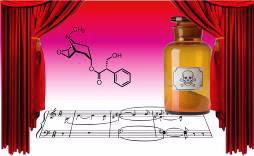FOR IMMEDIATE RELEASE | A PressPac Instant Replay*
ACS News Service Weekly PressPac: March 13, 2013
Opera's poisons and potions connect students with chemistry
“Opera and Poison: A Secret and Enjoyable Approach To Teaching and Learning Chemistry”
Journal of Chemical Education
Opera audiences can feel the chemistry in romance-inspired classics like Mimi's aria from La Bohème, Cavaradossi’s remembrance of his beloved while awaiting execution in Tosca and that young lady pining for her man with “O mio babbino caro” in the opera Gianni Schicchi. An article in ACS’ Journal of Chemical Education, however, focuses on the real chemistry — of poisons and potions — that intertwines famous operatic plots.
João Paulo AndrÉ points out that opera, in addition to being a form of theater, can be used as a teaching tool for chemistry students and the general public. In the article, based on an interactive lecture given at the University of Minho in Portugal and at other venues during the International Year of Chemistry, he cites numerous examples of themes involving chemistry that thread their way through some of the most famous operas.
One, for instance, is Samuel Barber’s opera Antony and Cleopatra. In the opera, Cleopatra takes her own life with a bite from a poisonous snake. The author explains the chemistry of snake bites and venom. A complex mix of neurotoxins, venom causes destruction of the victim’s tissues and even death. Others include Ambroise Thomas’ Hamlet, Verdi’s Simon Boccanegra and Mozart’s Mitridate, Re di Ponto.
The author acknowledges funding from Foundation for Science and Technology, QREN, FEDER/EU and Cie^ncia Viva, Portugal.
![]()
Contact
Science Inquiries: Michael Woods, Editor, 202-872-6293
General Inquiries: Michael Bernstein, 202-872-6042

could teach students and the general public
about chemistry.

